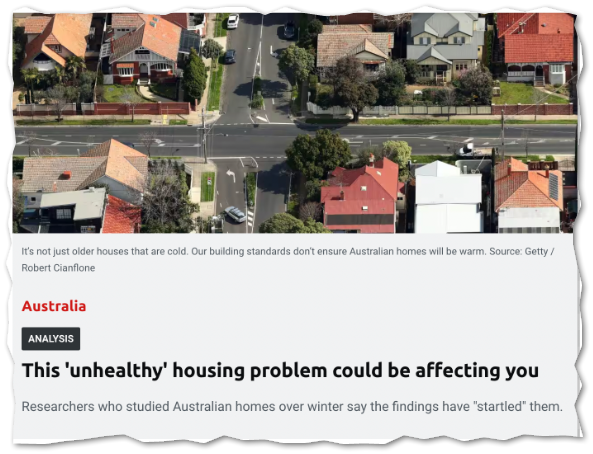
Australia is much warmer than New Zealand but apparently not inside their homes in winter. This new study points out that 80% (!) of the Australian homes measured failed to meet WHO recommendations for minimum indoor temperatures. We know from our own issues here in New Zealand that cold equals mould and poor health.
The problem of cold homes isn’t confined to low-income households—that’s one finding that jumped out at me. It also squares with my observations in New Zealand. There is some weird cultural notion at play in both countries it seems. Some folks who could afford to heat their homes properly still don’t. Instead they just put up with the cold, mould and impacts on their health.

(This phenomena is so perplexing that I dug into it specifically in my first book, Passive House for New Zealand. We sought out the opinions of social scientists and historians. You can find their comments in Chapter One, online here (pp 9-10 in the hard copy, a few of which are still available.)
For reference:
Cynthia Faye Barlow, Lyrian Daniel, Emma Baker,
Cold homes in Australia: Questioning our assumptions about prevalence
Energy Research & Social Science, Volume 100, 2023,
103124,ISSN 2214-6296,
A readable summary of the research was published by SBS.
Abstract
Australia is considered by many to be a warm climate country and hence winter cold and its health effects are often overlooked. The majority of the Australian population live in temperate climate regions, which are heating-dominated and experience cold wintertime conditions. The prevalence of cold in Australian homes has to date been rarely measured or estimated, and the few studies that do are based on proxy data that estimate a low prevalence (around 5 %). This paper tests these proxy measures, using high resolution temperature data on indoor temperature from 100 homes across temperate Australia. The data were assessed using the World Health Organization’s Housing and Health guideline for minimum indoor temperature (18 °C), which provides an internationally recognised benchmark for defining cold in homes. Across the sampled homes, 81 % were below 18 °C on average across the whole of winter (June–August 2022). Average winter indoor temperatures were 16.5 ± 2.7 °C across all homes, with no significant difference between locations. These early findings suggest that the problem of unhealthily cold homes in Australia is likely to be significantly more prevalent than previously estimated. Far from affecting 5 % of Australian households, the affected population may be 10 times this value. These initial findings have important implications for how we model health impacts and develop policy. This early release data from a recently commenced large environmental monitoring project is of timely importance. It challenges our understanding of the prevalence of cold housing in Australia context, flagging the pressing need to increase policy attention in advance of winter.
Keywords: Wintertime cold; Homes; Temperature; Temperate climate